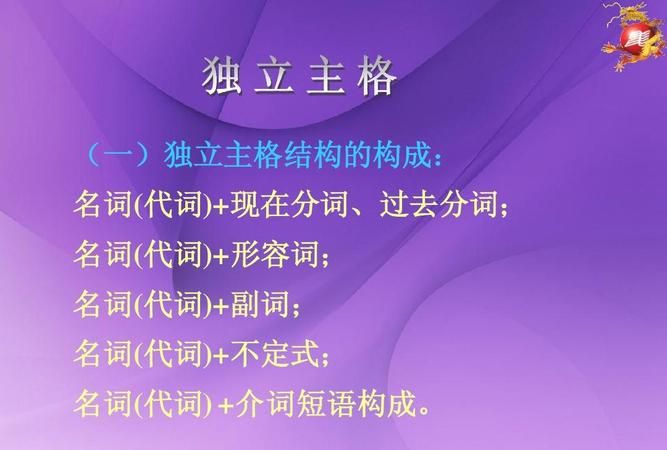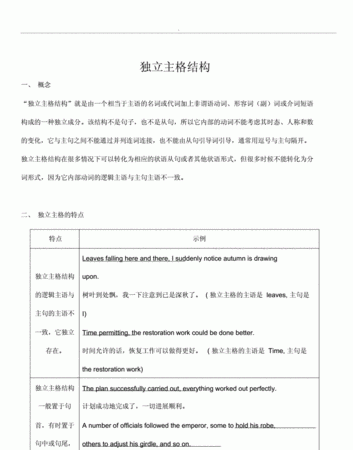本文目录
英语独立主格结构
英语独立主格结构
独立主格结构(Absolute Construction)由两部分组成,前一部分是名词或者代词,后一部分是非谓语动词(不定式、现在分词、过去分词)或形容词、副词、名词或介词短语。前后两部分具有逻辑主谓关系。
在英语中,动词按作用和功能主要分为两大类,一类是谓语动词,另一类是非谓语动词。独立主格结构在句中作状语,多用于书面语。独立主格结构本身不是句子,在句子中作状语,表时间、原因、条件、伴随、目的及状态等。

详细概述
非谓语动词作状语,其逻辑主语须与主句主语保持一致。若不一致,非谓语动词形式须另带主语,从而构成复合结构的形式作状语。这种结构称为“独立结构”。其中,非谓语动词主动用现在分词,被动用过去分词。
功能
独立主格结构主要用于描绘性文字中,其作用相当于一个状语从句,常用来表示时间、原因、条件、行为方式或伴随情况等。例如:
表示时间
The meeting being over, all of us went home. 开完会后我们都回家了。
Her work done, she sat down for a cup of tea. 她干完了活,坐下来喝茶。
表示条件
The condition being favourable, he may succeed. 如果条件有利,他或许能成功。
表示原因
There being no taxis, we had to walk. 没有出租车,我们只好步行。
He wrapped her up with great care,the night being dark and frosty. 夜又黑又冷,所以他把她裹得严严实实的。
In the middle of February,the weather being favorable for work,the workers began to repair and secure the dam of the river.二月中旬,天气有利于工作,工人们开始修缮河坝。
表示伴随情况
Almost all metals are good conductors,silver being the best of all. 几乎所有的金属都是良导体,而银则是最好的导体。(=Almost all metals are good conductors, and silver is the best of all.)
英语中什么是独立主格结构
问题一:英语里面的独立主格结构是什么意思? 1. 独立主格结构的构成:
名词(代词)+现在分词、过去分词;
名词(代词)+形容词;
名词(代词)+副词;
名词(代词)+不定式;
名词(代词) +介词短语构成。
(二) 独立主格结构的特点:
1)独立主格结构的逻辑主语与句子的主语不同,它独立存在。
2)名词或代词与后面的分词,形容词,副词,不定 式,介词等是主谓关系。
3)独立主格结构一般有逗号与主句分开。
举例:
The test finished, we began our holiday.
= When the test was finished, we began our holiday.
考试结束了,我们开始放假。
The president assassinated, the whole country was in deep sorrow.
= After the president was assassinated, the whole country was in deep sorrow.
总统被谋杀了,举国上下沉浸在悲哀之中。
Weather permitting, we are going to visit you tomorrow.
如果天气允许,我们明天去看你。
This done, we went home.
工作完成后,我们才回家。
The meeting gone over, everyone tired to go home earlier.
会议结束后,每个人都想早点回家。
He came into the room, his ears red with cold.
他回到了房子里,耳朵冻坏了。
He came out of the library, a large book under his arm.
他夹着本厚书,走出了图书馆
2. With的复合结构作独立主格
表伴随时,既可用分词的独立结构,也可用with的复合结构。
with +名词(代词)+现在分词/过去分词/形容词/副词/不定式/介词短语
举例: He stood there, his hand raised.
= He stood there, with his hand raise.
典型例题
The murder was brought in, with his hands ___ behind his back。
A. being tied B. having tied C. to be tied D. tied
答案D. with +名词(代词)+分词+介词短语结构。当分词表示伴随状况时,其主语常常用with来引导。由于本句中名词手与分词绑是被动关系,因此用过去分词,选D.
注意:
1) 独立主格结构使用介词的问题:
当介词是in时,其前后的两个名词均不加任何成分(如物主代词或冠词),也不用复数。但 with 的复合结构不受此限制
A robber burst into the room, knife in hand.
( hand前不能加his)。
2) 当表人体部位的词做逻辑主语时,及物动词用现在分 词,不及物动词用过去分词。
He lay there, his teeth set, his hand clenched, his eyes looking strai......>>
问题二:什么是独立主格句子?(英语) 独立主格结构是一个独立主格的名词或代词(作为逻辑主格),加上一个分词、形容词、副词、不定式、介词短语。其作用相当于状语,多用来表示行为、方式或伴随的情况,有时也用来表示时间和条件。这种结构多用在书面语中。
一、几种常见的独立主格结构形式
1.名词(或代词)+现在分词(或过去分词)。如:
1)The moon appearing,they decided to go on with theirjouney.
2)Good-bye said,he went home.
2.名词(或代词)+形容词。如:
3)The weather(being)hot,we all went swimming.
3.名词(或代词)+不定式。如:
4)Some of the money to be paid by the thief, the policewent.
4.名词(或代词)+介词短语。如:
5)He climbed in,sword in hand.
5.名词(或代词)+副词。如:
6)The meeting(being)over, we left the room.
独立主格结构的模式是:
主格名词/代词 + 分词/形容词/副词/不定式/介词短语
(作逻辑主语) (作逻辑谓语)
1. All our savings gone, we started looking for jobs.
2. The question settled, we went home.
3. The river having risen in the night, the crossing was impossible.
主格名词/代词 + 分词 (过去分词/现在分词)
主格名词/代词 + 形容词
1. His mother being ill, he had to stay home to look after her.
2. Other things being equal, I would buy the black dress.
主格名词/代词 + 副词
The meeting being over, our headmaster soon left
the meeting-room.
We to care for the children, you are able to be carefree
away from home.
主格名词/代词 + 不定式
主格名词/代词 +介词短语
Our English teacher came into the classroom, papers in hand.
with复合结构 与 独立主格结构
它们都可以在句中作原因状语,伴随状况状语,条件状语,时间状语或结果状语用,一般也可以相互转换.虽然它们的语法功能和意义相同,但其结构形式和名称却不相同.
with复合结构的模式是:
with+名词/代词+分词/形容词/副词/不定式/介词短语
独立主格结构的模式是:
主格名词/代词+分词/形容词/副词/不定式/介词短语
一,作时间状语
1,With winter ing on, the trees turn yellow and
some birds fly south.
......>>

什么是英语当中的独立主格结构形式
详见 ***/syy/zxyy/200809/9700.html
一、 独立主格结构的含义和实质
“独立主格结构”(absolute construction)又叫“独立结构”,是带有自己主语的非谓语动词分句和无动词分句。由于在语法上有自己的逻辑主语,结构上与主句不发生关系,因此传统语法叫做“独立主格结构”。其实,所谓“独立主格结构”并非真正独立,它还是一种从属分句,与主句紧密联系在一起,共同表达一个完整的意思,通常在句中起状语分句的作用。独立主格结构可放于句首、句尾,用逗号和主句隔开。
二、 独立主格结构的基本形式和功能
独立主格结构可以分为两部分:一部分是名词或代词,起逻辑主语的作用;另一部分是非谓语动词分句(现在分词、过去分词、不定式)或无动词分句(名词、形容词、副词、介词短语),表示前面名词或代词的动作或状态。
基本形式是:名词普通格/代词主格+现在分词/过去分词/不定式/名词/形容词/副词/介词短语,with引导的复合结构。
1. 名词/代词+ 现在分词
现在分词表示前面的名词或代词主动进行的动作或状态等。
例 The man lay there, his hands trembling.
So many students being absent, the meeting had to be put off.
His homework having been done, Tom went to sleep.
注:“独立结构”中的being或 having been 有时可以省去,这样就成了无动词分句或过去分词分句。
2. 名词/代词+过去分词
过去分词表示前面的名词或代词被动完成的动作或所处的一种状态。
例 The boy lay on his back, his hands crossed under his head.
The job not finished, we couldn’t see the film.
Her shirt caught on a nail, she could not move.
后面两个句子也可以看成省略掉了having been,being。如果加上,这两个句子就又变成了现在分词分句。
3. 名词/代词+不定式
不定式表示的是将来的动作。
例He suggested going for a picnic, Mary to provide the food.
These are the first two books, the third one to come out next month.
We shall get together at 7:30, the procession(游行) to start moving at 8 sharp.
4. 名词/代词+名词
名词一般做前面名词或代词的同位语。
例 Many people joined in the work, some of them women and children.
He fought the tiger,a stick his only weapon.
5. 名词/代词+形容词短语
形容词(短语)说明前面名词或代词的性质,状态,原因等。
例The floor wet and slippery, we had to stay outside for a while.
I heard that she got injured in the accident, my heart full of sorry.
这两个句子也可以看成是省略了being,如果加上,就变成了现在分词分句。
6. 名词/代词+副词
副词说明前面名词或代词的状态。
例 The meeting over, we all went home.
Nobody in, he left a message on the board.
He sat at the table, head down.
7. 名词/代词+介词短语
介词短语说明伴随前面名词或代词的方式或者状态。
例 The teacher came in, a book under his arm.
The hunter entered the forest, gun in hand.
Nobody at home, the thief took a lot of things away.
8. with引导的复合结构, 也可以认为是一种独立主格结构
例 A woman got on the bus with a baby around her arms.
The teacher came in with several students following behind.
With a lot of things to deal with, he will have a difficult time.
With the work done, he went out to eat.
He left the office with the lights on.
Mary rushed out of the house with the door open.
三、 学习独立主格结构应注意的一些问题
1. 独立主格结构中分句和主句的主语不一致
从以上例子我们可以看出,含有独立主格结构的句子,前后主语是不一致的,这也是独立主格结构和非谓语分句作状语的最重要区别。
例 (1) Hearing the news, he was very excited.
(2) Winter coming, it gets colder and colder.
在这两个句子里,第一个句子,前后的主语是一致的,都是he, 也就是说动词hear的动作发出者是主语he , 因此它是一个现在分词短语作状语表示原因的句子;而第二个句子,我们可以发现,有两个主语,第一个是动词come 的逻辑主语winter, 而第二个主语是句子真正的主语it,非谓语动词coming 和it 之间没有任何关系,因此它是一个独立主格结构。
2. 在独立主格结构中,动词是用现在分词还是过去分词
一般来说如果逻辑主语和动词之间是主谓关系,用现在分词。如:Time permitting, we will go out to play.一句中,time 和 permit 之间是逻辑上的主谓关系--- “时间允许”,因此用现在分词。 如果逻辑主语和动词之间是动宾关系,并且有被动的意思,用过去分词。如:“More time given,we should have done it better. ”一句中,time 和give 之间的关系是动宾关系,有被动的意思---“如果被给更多时间”,因此用过去分词。
3. 独立主格结构相当于一个状语从句
独立主格结构不是一个句子,而是相当于一个状语从句,可以表示时间、原因、条件、方式和伴随情况等。
例 Work done, John went home.相当于一个表示时间的状语从句:When the work has been done, John went home.
例There being no buses, we had to walk home.相当于一个表示原因的状语从句:Because there are no buses, we had to walk home.
4. 完成时态的运用
在独立主格结构中如果强调分词的时间发生在主句动作时间之前,常用现在分词的完成时态having done, 根据情况确定是用主动还是被动。
例The last bus having gone, we had to walk home.
His wallet having been stolen, he didn’t know what to do next.

什么是独立主格英语
一、独立主格结构的概念及基本构成形式
独立主格结构(the absolute structure)是由名词或代词加上分词或分词短语构成的一种独立结构,用于修饰整个句子,而不是一个词或词组。独立主格结构中的名词或代词与其后的分词或分词短语构成逻辑上的主谓关系。这种结构与主句不发生句法上的联系,独立主格结构的位置相当灵活,可置于主句前、主句末或主句中,常由逗号将其与主句分开。需特别注意的是,独立主格结构与主句之间不能使用任何连接词。例如:
1)Night enshrouding the earth,nobody could make out what the dark mass was from a distance.(黑夜笼罩大地,谁也看不清远处黑压压的一片是什么东西。)
2)He lay at full length upon his stomach,his head resting upon his left forearm.(他的脊背朝天,四肢伸展,头枕着左臂,直挺挺地趴伏着。)
3)The coward was backing,his face being deathly pale,toward another room.(那个胆小鬼向另一个房间退去,脸色煞白。)
独立主格结构多用于书面语,尤其是描述性语言中,在口语和非正式文体中,一般用从句或两个句子来代替。例如,上述例句可变为:
1)Because night enshrouded the earth, nobody could make out what the dark mass was from a distance.
2)He lay at full length upon his stomach.His head rested upon his left forearm.
3)The coward was backing toward another room.His face was deathly pale.
二、独立主格结构的特殊构成形式
独立主格结构除上述基本构成形式,即名词/代词+分词(短语)外,还有如下特殊构成形式。
1.名词+介词短语
1)The mayor of Hiroshima strode at a leisure pace toward the puzzled journalist,a bunch of flowers in his hands.(广岛市市长双手捧着一束鲜花,迈着方步走向那个迷惑不解的记者。)
2)Every afternoon a very old woman hobbled past the ramshackle house,a vast load of firewood on her back.(每天下午,一个背着一大背柴禾的老妇人都会从那间东倒西歪的房屋前蹒跚着走过。)
2.名词+形容词(短语)
1)The Trojans asleep,the Greek soldiers crept out of the hollow wooden horse.(特洛伊人睡着了,于是希腊士兵从中空的木马里悄悄爬了出来。)
2)The wretched boy,who has recently been dragged from the forest to scrub floors in the barracks,is now sweeping away the snow,his hands numb with cold.(那个可怜的小男孩最近刚刚从森林中被抓进兵营里打扫地板,现在他正在扫雪,手都冻麻了。)
3.名词+副词
1)This little excitement over,nothing was to be done but to return to a steadfast gaze at my mute companion.(一阵小小的兴奋过后,除了再去死死地盯着我的哑伴外,别无它事可干了。)
2)This intermezzo over,he found himself surrounded by several stunning,
porcelain-faced Japanese women in kimonos.(这曲子过后,他发现自己身处几位穿着和服并且有着娇好面容的日本女人的包围之中。)
此外,with常常用在独立主格结构前,构成介词短语作状语。这种用法中的with不表达什么意义,因而常可省略。请看例句:
1)With a revolver in his right hand, Johnny hurled his muscular body against the door and smashed it down with a crash.(约翰尼右手拿着左轮手枪,健壮的身体猛扑在门上,轰隆一声把门撞开了。)
2)The traffic inched along,with horns honking.(汽车缓慢地向前挪着,喇叭声不断响着。)
三、独立主格结构的用法
独立主格结构在句中一般作状语,表示时间、条件、原因、伴随状况等。
1.作时间状语
1)My shoes removed,I entered a low-ceilinged room,treading cautiously on the soft tatami matting.=After my shoes were removed, I entered a low-ceilinged room,treading cautiously on the soft tatami matting.(我脱掉鞋子后,走进一间屋顶很低的房间,小心翼翼地踩在柔软的塌塌米垫子上。)
2)The governor pondering the matter, more strikers gathered across his path.=While the governor was pondering the matter,more strikers gathered across his path.(总督思考这个问题时,更多的罢工工人聚集在他要通过的路上。)
2.作条件状语
1)Weather permitting,they will go on an outing to the beach tomorrow.=If weather permits,they will go on an outing to the beach tomorrow.(如果天气允许的话,他们将在明天组织一次海滨小游。)
2)Such being the case,you have no grounds for dismissing him.=If such is the case,you have no grounds for dismissing him.(如果情况如此的话,你没有理由解聘他。)
3.作原因状语
1)The storm drawing near,the navvy decided to call it a day.=Since the storm was drawing near,the navvy decided to call it a day.(由于暴风雨即将来临,那个挖土小工决定收工。)
2)The Cossack being intent on his stalking,his foot touched the protruding bough that was the trigger.=Because the Cossack was intent on his stalking,his foot touched the protruding bough that was the trigger.(这位哥萨克人只顾专心致志地朝前大步走着,所以一只脚踩上了伸出地面的树枝,那是一个机关的起动装置。)
4.作伴随状语
1)I took my ticket,and marched proudly up the platform,with my cheeses,the people falling back respectfully on either side.=I took my ticket,and marched proudly up the platform,with my cheeses,and the people fell back respectfully on either side.(我拿着车票还有我的奶酪,雄赳赳气昂昂地跨步走向月台。人们似乎很尊敬我,纷纷向两边退去。)
2)He would appear in the doorway,gray fedora pulled low over his face,his eyes sweeping the room for any sign of trouble.=He would appear in the doorway.A gray fedora was pulled low over his face,and his eyes swept the room for any sign of trouble.(他常常出现在门廊里,一顶灰色浅顶软呢帽遮住大半个脸,眼睛扫过整个房屋,寻找滋事的迹象。)
四、独立主格结构常见出题形式及解题策略
独立主格结构是一常考项目,在各级各类考试中多以语法结构填空形式出现。例如:
1)All flights ______ ,we decided to take a greyhound.
A.were canceled
B.had been canceled
C.having canceled
D.having been canceled
2)The production ______ steadily,the factory needs an ever-increasing supply of raw material.
A.has gone up B.is going up
C.having gone up D.being gone up
此类题型的解题策略可以概括为"结构分析法",即首先分析句子结构,判断句子缺少的成分,同时注意主句与其他部分之间有无连接词,是否用逗号隔开。若有逗号而无连接词,则可对选项部分作如下初步判断:1)选项部分可能会构成状语从句或非限制性定语从句(但二者必须由从属连词或关系代词、关系副词引导);2)选项部分可能会构成起状语作用的非谓语动词短语(但非谓语动词作状语时其逻辑主语通常为主句的主语);3)选项部分可能会构成起状语作用的独立主格结构(独立主格结构有自己的主语,并可扩展为状语从句或独立句子)。初步判断后,即可联系句子,对照选项,作出选择。
上述例题1)中的选项A和B与All flights构成了句子,但该句没有任何从属连词、关系代词或关系副词引导,与主句之间也无连接词,因而是错误的,应排除。选项C和D与All flights都可构成独立主格结构,作原因状语,但根据题意,应选D,因为"班机"是"被取消"的。
同样,例题2)中的选项A和B与名词the production构成了句子,但该句无连接词连接两个句子,因而应排除。选项C和D与the production都可构成独立主格结构,作原因状语,但根据题意,"产量在稳步增长",在逻辑上是主谓关系,应用主动语态,所以应选C。
此外,独立主格结构也时常见于其他诸如Cloze Test等题型中,并能广泛运用于写作和翻译之中。可见,掌握了独立主格结构对于学生提高综合应试能力是大有裨益的。

以上就是关于英语的独立主格是什么,英语独立主格结构的全部内容,以及英语的独立主格是什么 的相关内容,希望能够帮到您。
